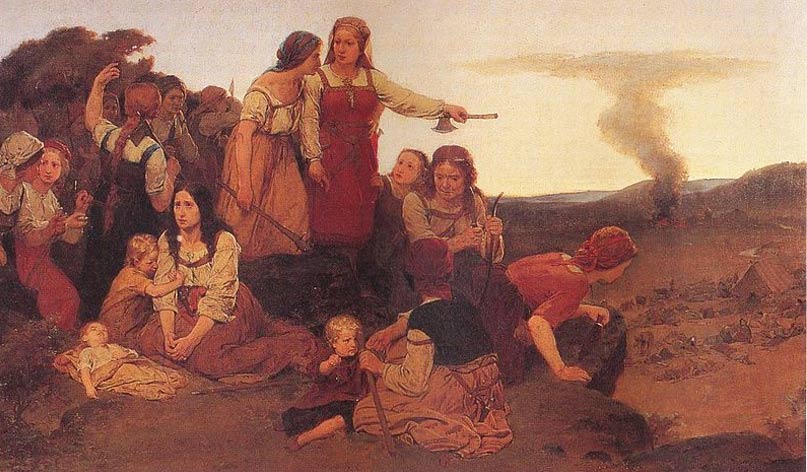Blenda: The Cunning and Courageous Swedish Woman Who Defeated the Danish Army
Blenda is a heroine found in Swedish myths and legends. It is unclear as to exactly when she lived, but according to the legends, her heroic deeds took place during the time when Alle was the King of the Geats, which is assumed to have been at some point between the 6th and 8th centuries AD. Blenda is remembered for her courage (and cunning) in leading a group of women against an invading Danish army.
Swedish Invasion
During the reign of King Alle, the Geats launched an attack against Norway. The King of the Geats mustered not only the West Geats, but also the South Geats (referred to also as the Riding Geats). The latter are from a region called Småland, where Blenda is said to be from too. As a result of this expedition, there were few fighting men left in the country, which meant that the kingdom was exposed to attacks from its enemies. The Danes to the south were aware of this, and seized the opportunity to invade Sweden and pillage their lands.
- Female Amazon warrior buried 2,500 years ago in Altai Mountains was... male
- Art of War: Onna Bugeisha of Japan and the Ancient Female Warrior Culture
- 2,500-year-old female Siberian warrior is beheaded by excavator
Småland was reckoned by the Danes to have been defenseless and they proceeded to attack. Little did they know, however, that this was the home of Blenda, and that she would not allow the Danes to just do as they pleased in Småland. Blenda is said to have been a woman of noble birth, and when she heard of the approach of the Danish army, she decided to rally the womenfolk to resist the invaders. She did this by sending the fiery cross (known also as ‘bidding sticks’, which are wooden stick-like objects used in Northern Europe to rally the people for various purposes) to women in the hundreds (a geographical division that was once used in Sweden) of Konga, Albo, Kinnevald, Norrvidinge and Uppvidinge.

The Girls of Småland by Hugo Hamilton (1830). (Public Domain)
Blenda’s Defense
The women responded to Blenda’s rallying cry with vigor. Blenda and her companions were aware that they would not stand a chance against the Danes if they were to fight them in a battle. Therefore, they resolved to use cunning instead and hatched a plot that would defeat their enemies. The leaders of this group of women approached the Danish warriors, and told them that they were very impressed by their prowess in battle. They then invited the soldiers to a banquet, where there was much feasting and drinking. The Danes had their fill of food and wine, got drunk, and fell asleep. The warriors never woke up again, as Blenda and her women butchered them in their sleep with axes and staves.
Rewards
When King Alle returned from his campaign against the Norwegians, he learnt of Blenda’s courage and cunning, and decided to bestow new rights on her and her companions as a reward. For example, they were allowed to have equal inheritance (in terms of land, property and money) as their husbands and brothers. Other privileges included the right to wear a belt around their waist, which was meant to be a sign of eternal vigilance, as well as the right to beat the drum at weddings.
- Gladiatrix: Female Fighters Offered Lewd Entertainment in Ancient Rome
- Amazon Warrior Woman on Horseback Discovered on 2,500-Year-Old Vase
- Secrets of the Four Gold Rings from the Tomb of the Griffin Warrior Revealed
Norse Mythology
The concept of female warriors is not entirely unknown in Norse society during the Viking Age. For instance, in Norse mythology there was a group of figures known as the Valkyrie. These were believed to be the handmaidens of Odin, the supreme god of the Norse pantheon. They were sent by this god to the battlefield to select warriors worthy of entering Valhalla after their deaths. The Valkyrie were portrayed as warriors, being equipped with helmets, mail-coats, and spears.

A valkyrie speaks with a raven (1862). (Public Domain)
Another instance of female warriors in Norse society may be seen in the Battle of Bråvalla, a legendary battle said to have taken place during the 8th century AD. It has been recorded that during the battle, 300 female warriors known as shieldmaidens fought on the side of King Harald Wartooth. Unlike the Valkyrie and the shieldmaiden, however, Blenda and her companions could be said to be a different sort of female warriors, as they relied more on cunning than brute force to defeat their enemies.

The Battle of Bråvalla. (Public Domain)
Top image: ‘Blenda’ by August Malmström. Source: Public Domain
By Ḏḥwty
References
History Gal, 2013. Legend of Blenda. [Online]
Available at: https://historygalblog.wordpress.com/2013/10/01/legend-of-blenda/
Jesch, J., 2014. Viking women, warriors, and valkyries. [Online]
Available at: https://blog.britishmuseum.org/2014/04/19/viking-women-warriors-and-valkyries/
Kane, N., 2017. The Legendary Battle of Bråvalla. [Online]
Available at: http://spangenhelm.com/battle-of-bravalla/
Allthatsinteresting.com. 2017. The Story Of Shieldmaidens – The Viking Warrior Women [Online]
Available at: https://allthatsinteresting.com/viking-shieldmaidens\
Kane, N., 2017. The Legendary Viking Heroine Blenda. [Online]
Available at: http://spangenhelm.com/legendary-heroine-blenda/
www.badassoftheweek.com, 2017. Blenda. [Online]
Available at: http://www.badassoftheweek.com/blenda.html



















